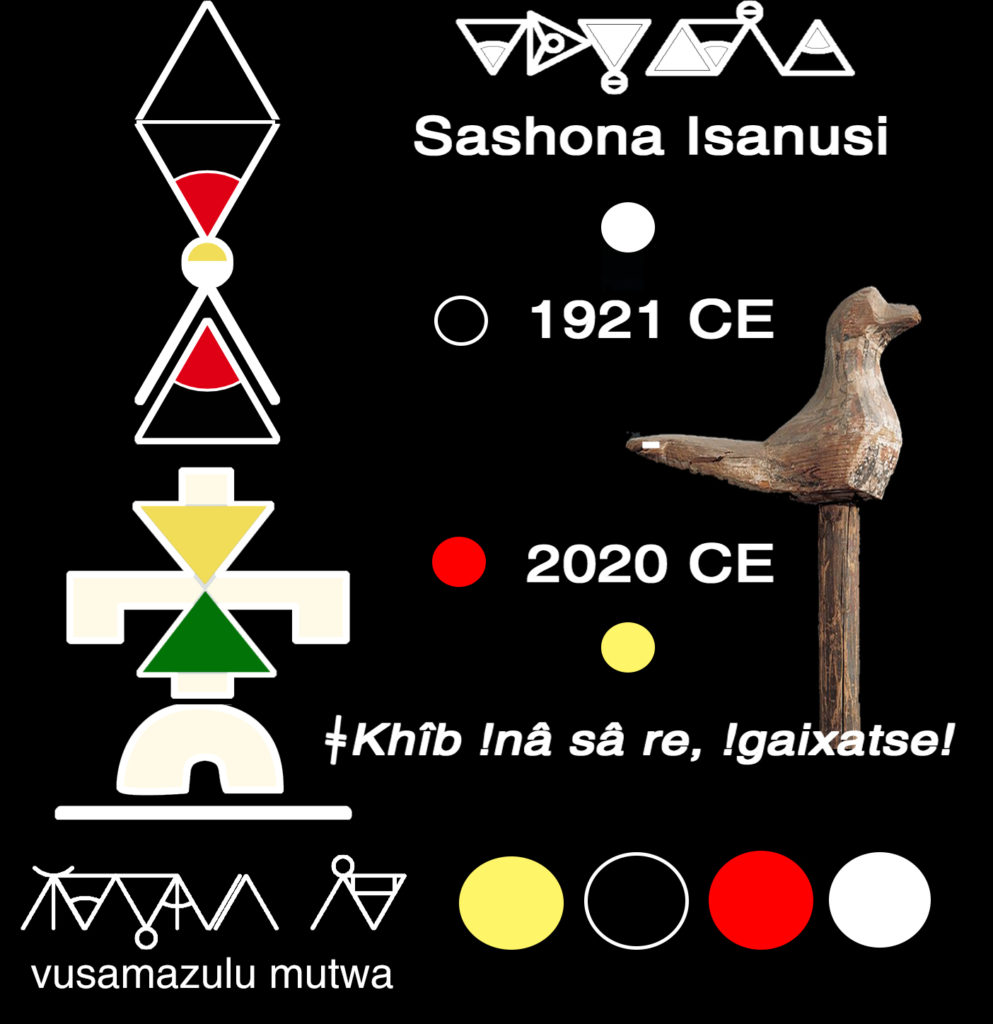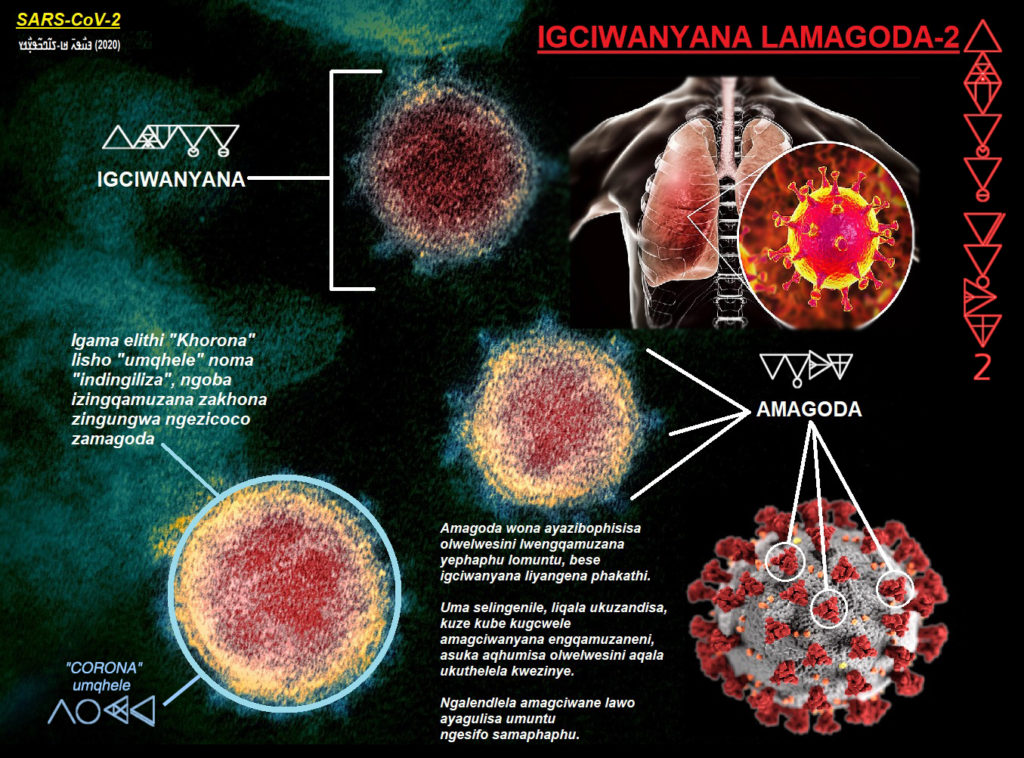EZINDABENI / DITABENG

Isanusi Sesizwe
(21 uNtulikazi 1921 CE – 25 uNdasa 2020 CE)

Igama elithi “Khorona” lisho “umqhele” noma “indingiliza”, ngoba izingqamuzana zakhona zingungwa ngezicoco zamagoda.
Amagoda wona ayazibophisisa olwelwesini lwengqamuzana yephaphu lomuntu, bese igciwanyana liyangena phakathi.
Uma selingenile liqala ukuzandisa, kuze kube kugcwele amagciwanyana engqamuzaneni, asuka aqhumisa olwelwesini aqala ukuthelela kwezinye.
Ngalendlela amagciwanyana lawo ayagulisa umuntu ngesifo samaphaphu.
Thola kabanzi: http://www.sacoronavirus.co.za
________
CORONAVIRUS-2
“The name ‘Corona’ means ‘crown’ or ‘circle’, because the cells in question are encircled with a ringlet of tufts.
The tufts adhere themselves to the membrane of the lung cell of a person, then the virus enters it.
When it has entered it begins to replicate itself, until the cell is full of viruses, which then burst the membrane and begin to infect other cells.
In this way these viruses make a person sick with lung disease.
More information: http://www.sacoronavirus.co.za

isibheqe sohlamvu
[isib̤ɛǃɛ sɔɬaːᵐvu]
♢⍚♢
ditema tsa dinoko
[ditʼɪma t͜sʼadinʊːkʼʊ]
⍚♢⍚
uhlelo lokuloba amazwi ezilimi zesintu
olunesimo oluvelo ebuciko bomdabu
a writing system for southern african languages
of a form that originates in traditional arts
mokwalo o moshwa wa puo ya setso
a new orthography for indigenous language

the system is used for all siNtu language of the region of Azania / !Naremâb, and is thought more efficient than the colonial Latin/Roman alphabets currently learned in schools, according to research on reading speeds here.

it is a free cultural technology that is derived from izimpawu zesintu such as litema tsa basotho, that is, it is based on well-established regional symbologies and received wisdom of indigenous knowledge systems:
uma ufuna ukulayisha i-PDF yencazo yoHLELO lokusetshenziswa kwesibheqe sohlamvu, uthinte la.
if you would like to download a PDF of the explanation of how the isibheqe sohlamvu system is used, click here.
open source isibheqe keyboard software that produces image files is currently available on this site, click here: LOBA! & the software can be downloaded for offline use here.
text wordprocessing will be available once ditema tsa dinoko is recognised by the Unicode Consortium – the body which ensures that computing devices can share or exchange text that is written in any language or with symbols.
- for detailed information on the how the script works, see the Wikipedia page here.
- pour des informations précises sur le fonctionnement du système, la page Wikipédia est ici.
- ここにisibheqeについての非常に興味深い話があります:
- further explanation of the system is available on Omniglot here:
- isibheqe / ditema is also on the Atlas of Endangered Alphabets here:
(ߔߎ߯ߟߍ ߞߊ-ߖߊ߬ߣߏ߬ߟߌ߲߯ߗߌ (߂߀߂߀
Isibheqe Sohlamvu / Ditema tsa Dinoko / Ditema Syllabary / Lapha kutholakele khona isizindalwazi sohlelo lokuloba amazwi ezilimi zesiNtu olunesimo oluvela ebuciko bomdabu, olubizwa ngokuthi yisiBheqe SoHlamvu. Ditema tsa Dinoko ke mokwalo o moshwa wa puo ya setso. This is the decolonial Southern African writing system, Isibheqe/Ditema Featural Syllabary. It is used to write all Southern Ntu languages (so-called “Southern Bantu Languages”) of the the region of Azania / Ἀζανία / زنجي / 澤散 and !Naremâb which encompasses South East Afrika, and SADC states such as the Republics of South Africa, Botswana, Eswatini, Mozambique, Zimbabwe, Zambia, and Lesotho.  These language forms that it best represents fall into the typological language groups called Nguni, Sotho-Tswana, Venḓa, Tsonga and Tonga-Inhambane. Language labels such as Sesotho, Setswana, IsiZulu, IsiXhosa, SiSwati, SiPhuthi, Xitsonga, EMakhuwa, ChiNgoni, SiLozi, or Tshivenḓa, constitute members of these groups. The Isibheqe/Ditema orthography is an alternative literacy in line with principles of decoloniality. It is drawn from antecedent izimpawu zesiNtu ideograms as listen by the likes of Vusamazulu Credo Mutwa as being the rarefied symbols of isanusi / isangoma / igqirha / !gaixa / ngaka, and explained by the those such as of Bárbaro Martínez-Ruiz in his book on Kongo Graphic Writing Symbols, for example. Siyabuyela eMbo. Sankofa. Siyacamagusha. Ka pula, pula a e ne!
These language forms that it best represents fall into the typological language groups called Nguni, Sotho-Tswana, Venḓa, Tsonga and Tonga-Inhambane. Language labels such as Sesotho, Setswana, IsiZulu, IsiXhosa, SiSwati, SiPhuthi, Xitsonga, EMakhuwa, ChiNgoni, SiLozi, or Tshivenḓa, constitute members of these groups. The Isibheqe/Ditema orthography is an alternative literacy in line with principles of decoloniality. It is drawn from antecedent izimpawu zesiNtu ideograms as listen by the likes of Vusamazulu Credo Mutwa as being the rarefied symbols of isanusi / isangoma / igqirha / !gaixa / ngaka, and explained by the those such as of Bárbaro Martínez-Ruiz in his book on Kongo Graphic Writing Symbols, for example. Siyabuyela eMbo. Sankofa. Siyacamagusha. Ka pula, pula a e ne!











